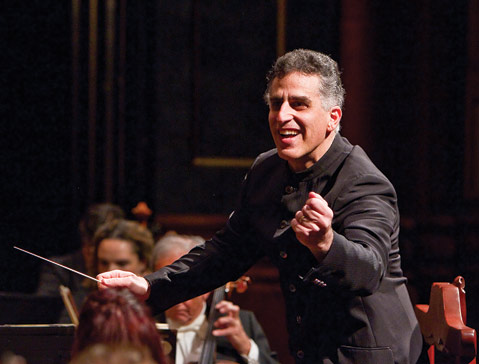S.B. Symphony Gives West Coast Premiere May 14-15
Lost Souls Is a New Piano Concerto by Avner Dorman

Lost Souls is an evocative name for a piece of music. It conjures up thoughts of those who have gone before us, and suggests that the past continues to haunt the present, often in unexpected ways.
That makes it a perfect title for the piano concerto of Avner Dorman, which will receive its West Coast premiere during this weekend’s season-finale concerts of the Santa Barbara Symphony. Alon Goldstein, who gave the work its premiere in Kansas City in 2009, will be at the keyboard.
The 36-year-old Dorman, who was born in Israel, educated in New York (he studied composition with John Corigliano at Juilliard), and lives in Los Angeles, is rapidly being recognized as a major talent; he was profiled by the New York Times in April. He answered some questions about his work via email.
Please explain the central idea behind Lost Souls. Is it fair to say the pianist is summoning the “ghosts” of great composers of the past and performing music written in their styles? Maybe it’s more that the orchestra is summoning the “ghosts” of past concertos, and the pianist represents those concertos as they return from the afterlife.
You wrote this work specifically for Alon Goldstein. What specific qualities of his playing did you have in mind as you wrote the piece? Alon is a fantastic pianist and musician on so many levels. Knowing the breadth of what he can do gave me great freedom writing the piece. Listening to Alon, I am always struck by how, in very soft and simple sections, he manages to captivate the listener. It always seems very intimate and close when he plays these sections, even in a large hall. In the second movement of the concerto, I gave him the opportunity to shine in this way in his first, second, and last entries.
The other thing that I tried to exploit is how Alon is transformed when he plays wild contemporary music. Alon has played my second piano sonata many times, and whenever he plays the second movement, it’s almost like he’s possessed. The last movement of Lost Souls certainly gives him the opportunity to play some exciting, wild, new music.
I see from the reviews—including a rave in the Washington Post—that performances of the work include certain theatrical elements, including lighting effects. Why did you make that choice? The concerto, by definition, is a dramatic medium (the soloist is the protagonist, etc.). Today we are less sensitive to the dramatic effect of concertos such as Beethoven’s 4th, or Mozart’s 9th that begin with the soloist playing. But if one considers how formal the culture was when they were written, it must have been a real shock to audiences. Of course, nowadays, we have to go a bit further to surprise our audiences.
Like so many of your contemporaries, you have had the term “multicultural” attached to your music. Is incorporating sounds of different cultures and eras a conscious decision on your part, or something that came naturally, given your background and the music you listened to during your formative years? I think it’s both. Growing up in Israel was certainly a multicultural experience. It’s interesting, though, that in Israel, my music is characterized as less multicultural, because in many ways it reflects the local culture.
Pianist Orli Shaham just premiered my Third Violin Sonata with her brother Gil Shaham, and she said that playing the piece feels a lot like driving in a car in Israel and changing the channels on the radio receiver. It’s just that the stations there play different things than what most Americans or Europeans usually listen to.
4•1•1
The Santa Barbara Symphony, conducted by Nir Kabaretti, performs works by Brahms, Dorman, and Dvořák on Saturday, May 14, at 8 p.m. and on Sunday, May 15, at 3 p.m. at The Granada (1214 State St.). Saturday night’s concert will be broadcast live on KDB, 93.7 FM. For ticket information, call 899-2222 or visit thesymphony.org.



